
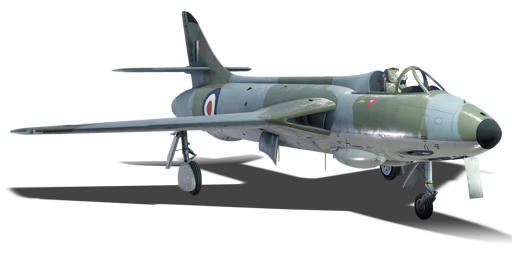


The early variants of the Hawker Hunter, the F.1 and F.2, faced significant issues including a lack of range and compressor stalls caused by the nose-mounted armament. These problems were addressed through the development of improved designs, the Avon-engined F.4 and Sapphire-engined F.5, which featured increased fuel capacity and modifications to the armament. These were further developed into the Hunter F.6, which had a larger engine, altered wing design, and increased fuel capacity. The F.6 became the Royal Air Force's frontline fighter until 1963, when it started being replaced by the English Electric Lightning. While Hunters in RAF service never carried any guided air-to-air armament, one Hunter F.6 was used as a testbed for the development of the Hawker Siddeley SRAAM, an alternative to AIM-9B Sidewinder and Firestreak missiles. Although the SRAAM program was eventually canceled, its design work laid the foundation for the AIM-132 ASRAAM.
Introduced in Update 1.89 "Imperial Navy", the Hunter F.6 is a further improvement of the preceding Hunter F.1 with a more powerful engine, retaining the excellent high-speed manoeuvrability and energy retention, as well as the complement of potent 30 mm ADEN cannons. However, its main feature is the extremely manoeuvrable but also extremely short range SRAAM missiles, whose thrust-vectoring capabilities allow them to easily hit targets at most angles within a 1 km radius. Unfortunately, they are very easily decoyed by flares. Being a subsonic airframe and lacking an afterburner, the Hunter F.6 is typically slower than its contemporaries at the battle rating, as well as lacking other increasingly common features such as countermeasures, RWR, or radar.
flaps
flaps
flaps
brake
| Belt | Belt filling | Armor penetration (mm) at a distance: | |||||
|---|---|---|---|---|---|---|---|
| 10 m | 100 m | 500 m | 1000 m | 1500 m | 2000 m | ||
| AP/HEI-T | 37 | 34 | 22 | 13 | 8 | 5 | |
| AP/HEI-T/AP | 37 | 34 | 22 | 13 | 8 | 5 | |
| HEF-I/HEI-T | 4 | 4 | 4 | 4 | 4 | 4 | |
| AP/HEF-I | 37 | 34 | 22 | 13 | 8 | 5 | |
| Name | Weight | Slot | ||||||||||||
|---|---|---|---|---|---|---|---|---|---|---|---|---|---|---|
| 3 × | 81.8 kg | 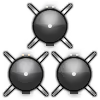 |  |  |  |  |  |  |  | |||||
| 43.1 kg | 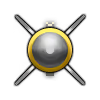 |  |  |  |  |  |  |  | ||||||
| 62.8 kg | 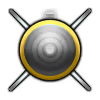 |  |  |  |  |  | ||||||||
| 18 × | 183.9 kg |  |  | |||||||||||
| 213.1 kg |  |  |  |  | ||||||||||
| 474.4 kg |  |  |  |  | ||||||||||
| 86 kg |  |  | ||||||||||||
| 2 × | 156 kg | 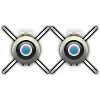 |  | |||||||||||
| Drop tank (150 gal.) | 73 kg |  |  | |||||||||||












Flight performance | |
|---|---|
Survivability |
|---|
Weaponry | ||
|---|---|---|